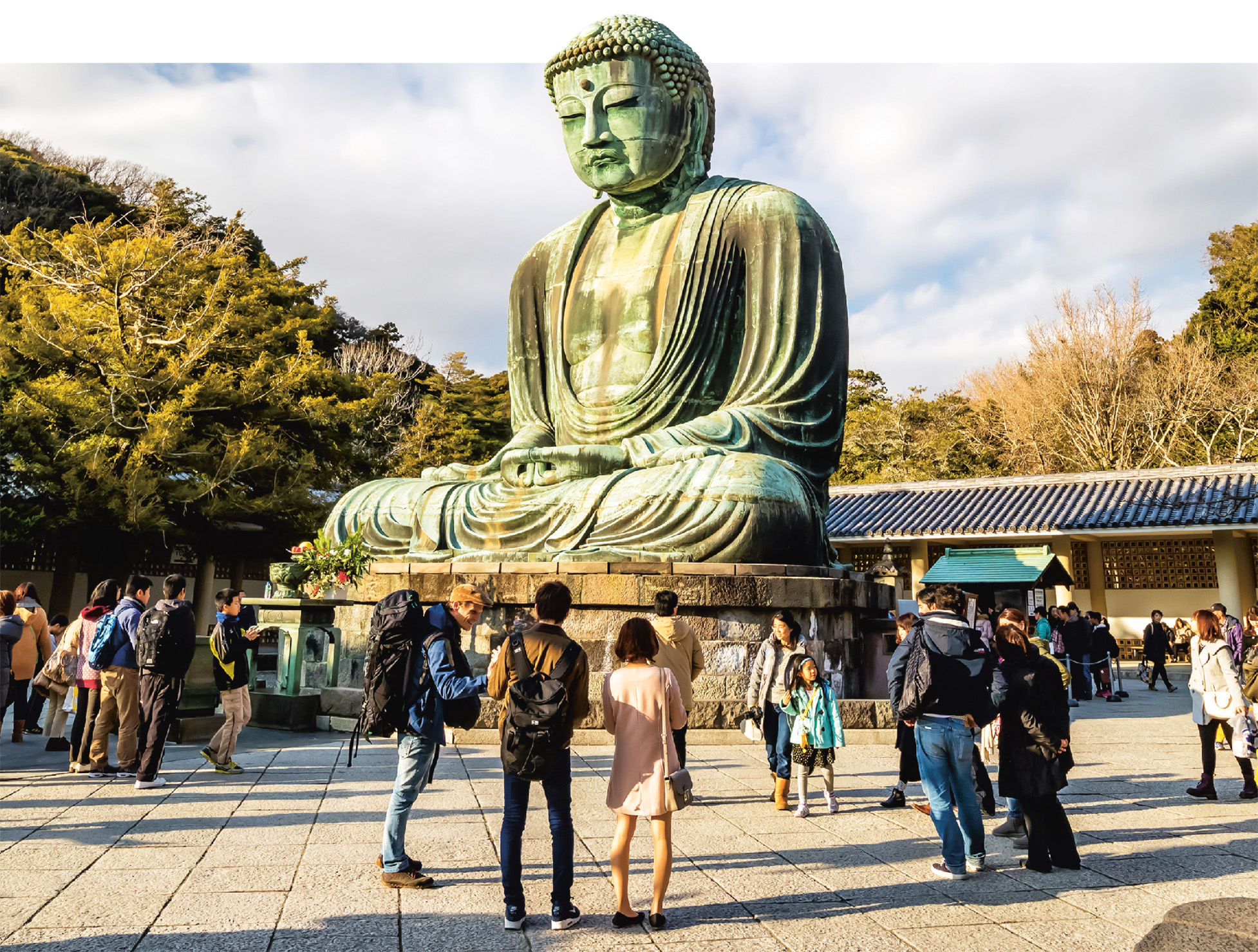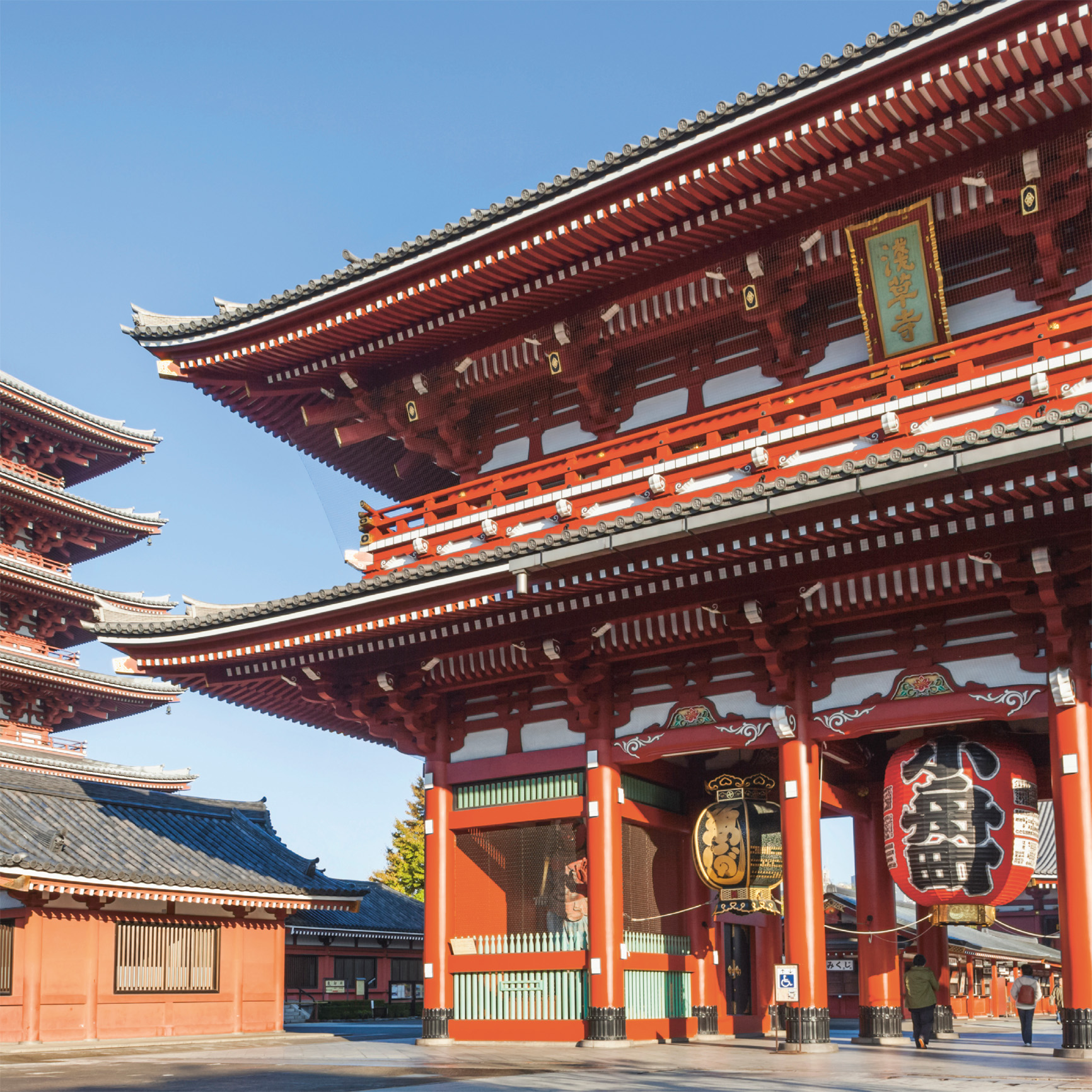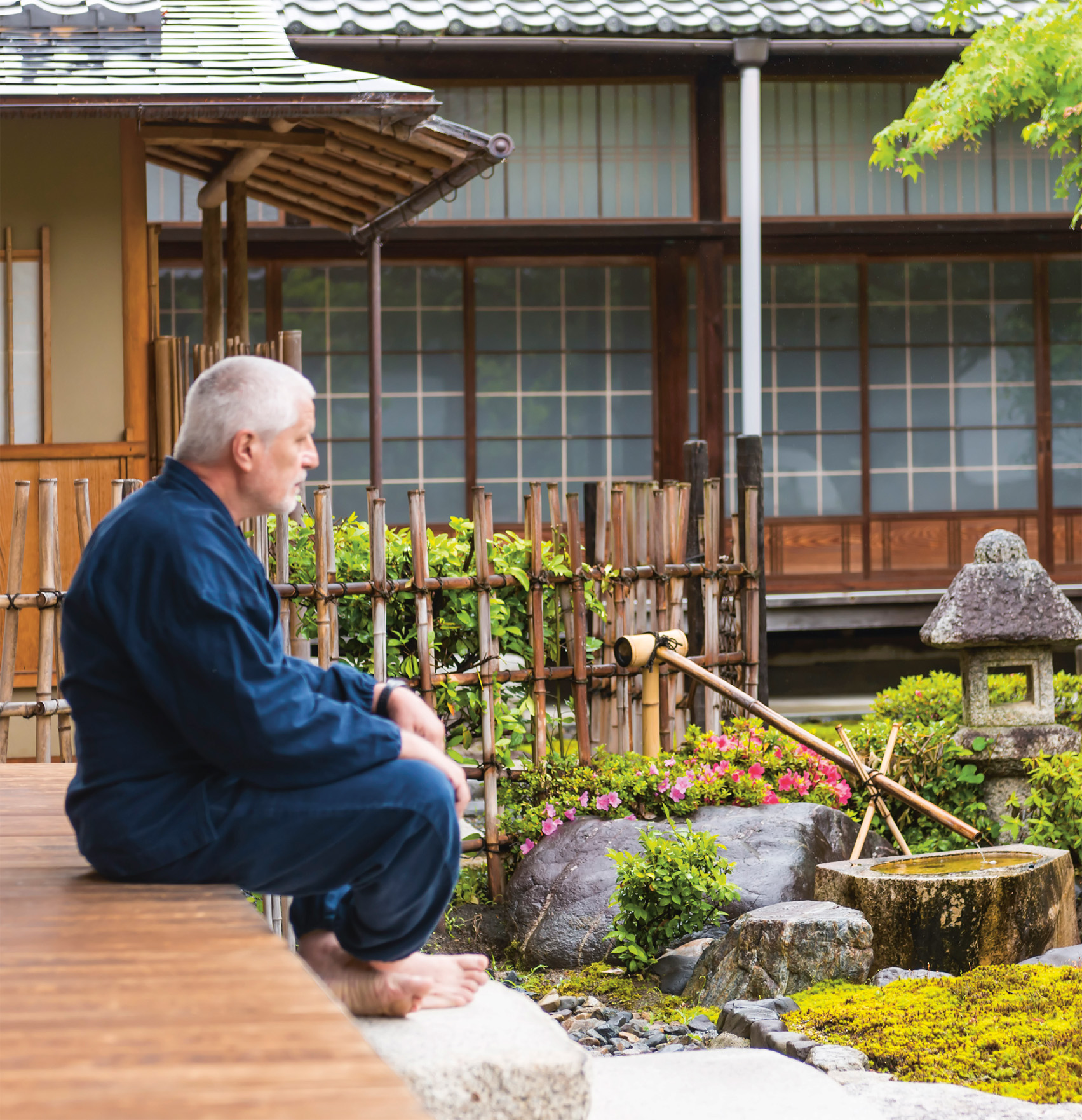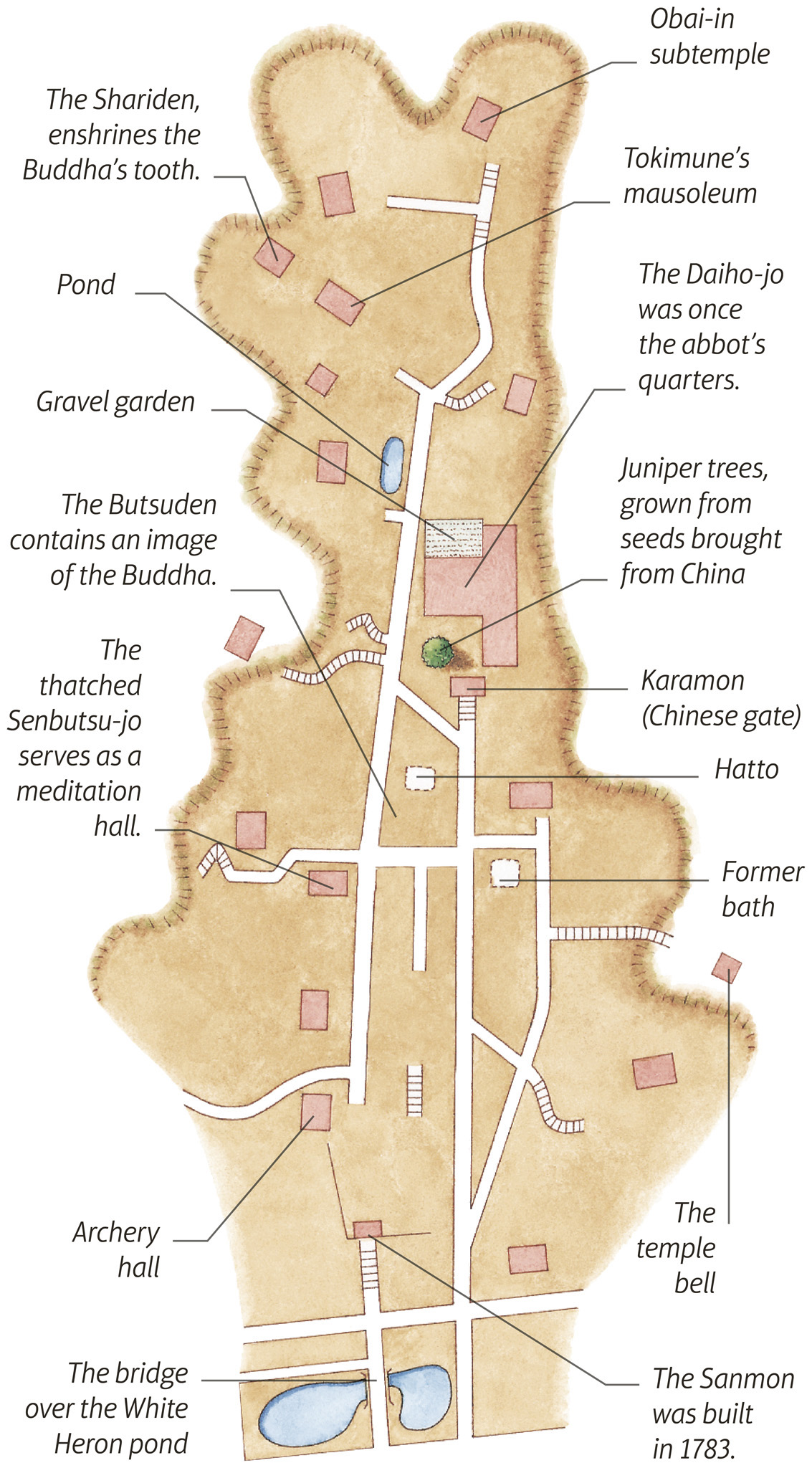g Beyond Tokyo g Contents
A seaside town of temples and wooded hills, Kamakura was Japan’s administrative capital from 1192 until 1333. Favored by artists and writers, Kamakura has numerous antique and crafts shops, and in cherry-blossom season and on summer weekends, it teems with visitors.

t Sagami Bay and rooftops of Kamakura houses from Hase-dera Temple
Experience Beyond Tokyo

n Double-tap image to read the labels
The Great Buddha (Daibutsu) is Kamakura’s most famous sight. Cast in 1252, the bronze statue of the Amida Buddha is 44 ft (13.5 m) tall. Its proportions are distorted so that it seems balanced to those in front of it – this use of perspective may show Greek influence (via the Silk Road).
Did You Know?
The Great Buddha has shock absorbers in its base to protect it from earthquakes.
Simple and elegant, Hase-dera is home to a superb 11-faced Kannon, bodhisattva of mercy. The Treasure House displays characterful Muromachi-era carvings of the 33 incarnations of Kannon. There is also a sutra repository; rotating the sutras is said to earn as much merit as reading them.
The 1264 bell is the town’s oldest. Below it is a hall dedicated to Jizo, guardian of children, surrounded by countless statues to children who have died or been aborted.

INSIDER TIP
Getting Around
Some parts of the town are best explored on foot but, with so many hills, it’s worth buying a one-day bus pass from Kamakura station. The energetic can also rent a bicycle from here.
On a hillside of soaring trees, this temple, with its unusually steep, extended roof, is the town’s largest belonging to the Nichiren Buddhism sect. It was established in 1260, in memory of a 1203 massacre against the Hiki clan.

t The hongu (main hall) of the ornate Tsurugaoka Hachiman-gu Shrine
Japan’s Hachiman shrines are dedicated to the god of war; this one is also a guardian shrine of the Minamoto (or Genji) clan. Built in 1063 beside the sea, it was later moved here in 1191, and reconstructed in 1828. The approach runs between two lotus ponds: the Genji Pond has three islands (in Japanese san means both three and life) while the Heike Pond, named for a rival clan, has four (shi means both four and death). To the south, the Kamakura National Treasure House Museum contains a wealth of temple treasures.
This secluded temple is known for its naturalistic garden. Created in 1327 by the monk Muso Soseki, it features a waterfall-fed lake, rocks, and sand; a Zen meditation cave is cut into the cliff. Decorative narcissi also bloom here in January, and Japanese plum trees blossom in February making it an idyllic natural oasis even before the cherry trees bloom.
Founded in 734, this is the oldest temple in Kamakura, and pleasantly informal. The softly thatched hall contains three wooden statues of 11-faced Kannon, protected by ferocious guardian figures at the temple gateway.

t The main gate to Hokoku-ji, surrounded by bamboo forest
This Rinzai Zen temple was founded in 1334 and boasts a lovely bamboo grove, which you can visit for a fee, as well as a pleasant rock garden. The temple’s Sunday-morning zazen (meditation) sessions are open to all.
Kencho-ji is the foremost of Kamkura’s “five great” Zen temples, and the oldest Zen training monastery in Japan. Founded in 1253, the temple originally had seven main buildings and 49 subtemples; many were destroyed in fires, but ten subtemples remain. Beside the impressive Sanmon Gate is the bell, cast in 1255, which has a Zen inscription by the temple’s founder. The Buddha Hall contains a Jizo bodhisattva, savior of souls of the dead. Behind the hall is the Hatto, where public ceremonies are performed. The Karamon (Chinese gate) leads to the Hojo, used for services. Kencho-ji’s beautiful rear garden is constructed around a pond supposedly in the shape of the kanji character for heart or mind. To the side of the temple, a tree-lined lane leads to subtemples and up steps to Hanso-bo – the temple’s shrine.
Known as the “hydrangea temple,” Meigetsu-in is a small Zen temple with pretty gardens. As well as hydrangeas – which are at their peak in June – there are irises that bloom in late May, when the rear garden, usually only tantalizingly glimpsed through a round window, is opened to the public.
This quiet little temple was set up as a convent in 1285, at a time when only men were allowed to petition for divorce. If a woman spent three years in a convent she could divorce her husband. Thus Tokei-ji was known as the “divorce temple.” In 1873 the law was changed to allow women to initiate divorce, and in 1902 Tokei-ji became a monastery. It is still refuge-like, its gardens stretching back to wooded hillside.

t Inside the grand Butsunichian, the mausoleum of the founder of Engaku-ji
The largest of Kamakura’s “five great” Zen temples, and set deep in trees, Engaku-ji was founded by the Hojo regent Tokimune in 1282. An influential zazen (meditation) center since the Meiji era, it now runs public courses.
Although much of Engaku-ji was destroyed by the 1923 Kanto Earthquake, 17 of its more than 40 subtemples remain, and careful rebuilding has ensured that it retains its characteristic Zen layout. One of its highlights, in the Shozoku-in subtemple, is the Shariden, which houses the relics of the Buddha. Japan’s finest example of Chinese Sung-style Zen architecture, it is open only at New Year but can be seen through a gate at other times. Farther on, the Butsunichian – the mausoleum of Engaku-ji’s founder – serves matcha tea to visitors. This was the setting for Kawabata Yasunari’s 1949 novel Senbazuru (Thousand Cranes).
This popular shrine is dedicated to Benten, goddess of the arts and eloquence, and one of the “seven lucky gods” of folk religion. Hidden in a niche in the cliffs, it is approached through a small tunnel and a row of torii gates. These lead to a cave spring where visitors wash coins in the hope of doubling their value.
Experience Beyond Tokyo
|
EAT Oimo Cafe Kanaria This eatery near Kamakura station serves up parfaits and kakigori (shaved ice with syrup). Try one of the classic flavors, such as green tea or adzuki bean. ⌂ 1F Enomoto Bldg, 2-10-10 Komachi, Kamakura-shi, Kanagawa 248-0006 ¢ Dinner, Wed ∑ oimocafe.exblog.jp |
Experience Beyond Tokyo
Buddhism in japan

t The contemplative bronze figure of the Great Buddha in Kamakura
Since the first priests from mainland Asia brought Buddhism to Japan in the 6th century, usurping the native Shinto, hundreds of separate Buddhist movements, sects, and subsects developed in the country. Contrasting beliefs appealed to different groups of nobility, samurai, and commoners, who each adapted practices to their own ends. In the eyes of many visitors today, Zen, one-time favorite of the samurai, is the quintessential religion of Japan, but it is just one of several major movements, and is itself subdivided into various sects. Of the other movements, the Tendai and Shingon sects of esoteric Buddhism still have millions of devotees.
ZEN BUDDHISM
This school developed during the Kamakura period (1185–1333). There are three main sects: Soto, Rinzai, and Obaku. All place emphasis on zazen (sitting meditation) and self-help.
SHINGON
Founded in Japan in the 9th century by the monk Kukai, this branch incorporates Hindu elements, such as hand gestures (mudra) and the chanting of mantras.
TENDAI

t Senso-ji temple once belonged to the Tendai sect but is now a Sho-Kannon temple
Brought to Japan in the 9th century by the monk Saicho, Tendai places emphasis on selfless devotion. From its base at Mount Hiei, Tendai spawned the Jodo, Jodo Shin, and Nichiren sects.
SHUGENDO
This offshoot of Shingon combines philosophies from Buddhism, Shinto, and Taosim, and promotes ascetic practices on mountain retreats.
Experience Beyond Tokyo
The Layout of a Zen Buddhist Temple

Designed to facilitate the path to enlightenment, Zen Buddhist temples transport worshippers from the earthly world to that of the Buddha. Based on Chinese Sung-dynasty structures, Japanese Zen temples are usually set out in a straight line. The entrance is marked by a bridge over a water, symbolizing the overcoming of earthly obstacles. The main buildings include the Sanmon (main gate), Hatto lecture hall, Butsuden (Buddha Hall), meditation or study hall, and the abbot’s and monks’ quarters. Often made of unpainted wood, they are intended to be conducive to emptying the mind of worldly illusions.

t The layout of Engaku-ji, a Zen Buddhist temple in Kamakura
